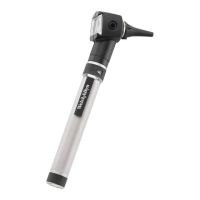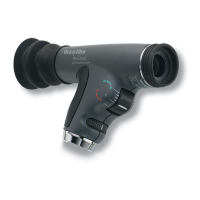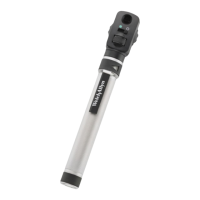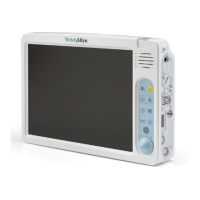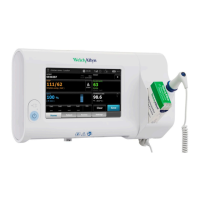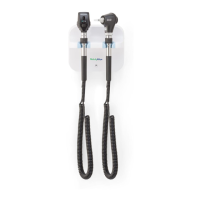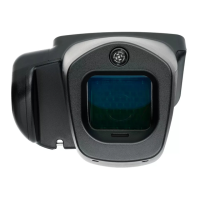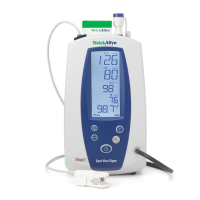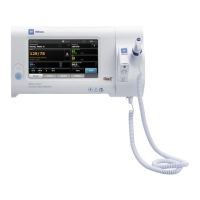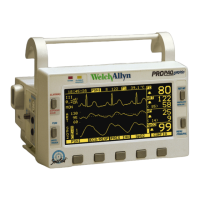
Do you have a question about the Welch Allyn Propaq Encore 202EL and is the answer not in the manual?
| Brand | Welch Allyn |
|---|---|
| Model | Propaq Encore 202EL |
| Category | Medical Equipment |
| Language | English |
Provides crucial warnings and cautions for safe operation of the Propaq Encore monitor.
Explains symbols used in documentation and on the Propaq Encore monitor for clarity.
Details the components of the Propaq Encore documentation set for users and technicians.
Describes the scope and content of this specific reference guide for Propaq Encore models.
Outlines the expected knowledge and responsibilities of the reader using this guide.
Provides a general introduction to the Propaq Encore vital signs monitor.
Details the different Propaq Encore models and the available optional features.
Describes the Propaq Encore Expansion Module and its role in housing additional capabilities.
Details the Pulse Oximetry (SpO2) option, including sensor types and installation.
Explains the Capnography (CO2) options, including Mainstream, Sidestream, and Dualstream.
Describes the RESP option for detecting respiratory effort and its configuration.
Details the Printer Option, providing a lightweight 3-channel recorder.
Explains the option for communicating with the Acuity Central Monitoring System via Ethernet.
Describes the option for telecommunication with the Acuity System via external modems.
Details the HP connector option for compatibility with Hewlett-Packard sensors and accessories.
Identifies and describes the physical controls located on the right side panel of the monitor.
Explains the connector for LIFEPAK defibrillator synchronization for cardioversion.
Describes the connector providing a real-time analog ECG signal output.
Explains the function of the green light indicating battery charging status.
Details the connector for Acuity System connection or modem telecommunication.
Describes the function of the red ALARM light and yellow ALARM(S) OFF light.
Explains the information displayed and diagnostics run when the monitor is first turned on.
Describes an alert indicating lost settings and the steps to recover.
Illustrates and describes connectors for optional modules like CO2 and SpO2.
Identifies and explains the function of the four main buttons on the screen sides.
Provides a step-by-step guide to access Setup Menu 1 through button presses.
Details the key presses required to navigate to Setup Menu 2.
Explains the options available within Setup Menu 1 for configuring the monitor.
Explains how to change and set the patient mode (Adult, Pediatric, Neonatal).
Guides users on how to choose which waveforms are shown on the monitor.
Details the process for setting the monitor's current time and date.
Explains how to modify date format, ECG filter, and measurement units.
Describes how to set and customize patient modes for powerup and operation.
Details the Mode Setup window for configuring patient modes and powerup defaults.
Lists and explains error messages related to printer malfunctions.
Explains how to use the in-service mode for practicing monitor functions without a patient.
Lists the operations that can be performed while the monitor is in in-service mode.
Lists the limitations of the in-service mode regarding calibration and specific functions.
Covers the setup and use of ECG and Impedance Pneumography (RESP) monitoring.
Details the intended use of the Propaq Encore for ECG monitoring with different lead configurations.
Guides on using correct ECG connectors and accessories for safety and performance.
Outlines the steps for preparing the monitor and the patient for ECG/RESP monitoring.
Explains how to configure the ECG and RESP channels, including lead selection and bandwidth.
Guides on setting appropriate alarm limits for ECG and RESP vital signs.
Explains how ECG and RESP data are presented on the Propaq Encore display.
Describes the menus and status windows related to ECG and RESP monitoring.
Details the specific selections available for the Impedance Pneumography option.
Details specific selections for Impedance Pneumography (RESP) including leads and response settings.
Provides guidance on using the Propaq Encore with patients who have pacemakers.
Explains how the Propaq Encore detects and indicates pacemaker signals.
Describes how pacemaker signals are visually indicated on the Propaq Encore display.
Details how to enable or disable the pacemaker indicator function.
Discusses noise issues affecting the ECG signal and potential solutions.
Explains how to use the built-in filter to reduce noise and improve ECG waveform clarity.
Lists and explains messages related to ECG lead faults or changes.
Lists and explains error messages specific to the RESP (Respiration) channel.
Details the intended use of the invasive pressure channel for measuring various pressures.
Guides on selecting and connecting appropriate transducers for invasive pressure monitoring.
Outlines the steps for preparing the transducer and zeroing it for invasive pressure monitoring.
Explains how to configure the invasive pressure channel settings like range and format.
Guides on setting alarm limits for invasive pressure measurements.
Describes how to rezero a transducer at any time for accurate readings.
Explains how pressure waveforms and numeric values are presented on the Propaq Encore display.
Lists and explains messages related to invasive pressure measurements and transducer status.
Details the intended use of the Noninvasive Blood Pressure (NIBP) channel.
Explains how the Smartcuf filter enhances NIBP measurement accuracy, especially with motion artifact.
Guides on selecting and using appropriate NIBP connectors and cuffs for different patient age groups.
Outlines the three steps for preparing NIBP monitoring: cuff placement, channel setup, and alarm limits.
Details how to access the NIBP menu and set up the channel, including modes and Smartcuf.
Explains how NIBP numerics can be displayed within a waveform window.
Guides on setting appropriate alarm limits for NIBP measurements.
Explains how to select waveforms and view default NIBP display settings.
Provides details on how automatic NIBP measurements are scheduled and initiated.
Lists and explains various NIBP error and caution messages.
Details the intended use of the temperature monitoring function and unit selection.
Guides on using approved temperature probes and connectors for accurate readings.
Outlines the steps for preparing the patient and monitor for temperature measurement.
Explains how temperature measurements are numerically displayed on the Propaq Encore screen.
Lists and explains messages related to temperature probe detection and calibration errors.
Describes the intended use of pulse oximetry, factors affecting accuracy, and sensor application.
Guides on attaching and using the Masimo SpO2 sensor and interpreting its display.
Details the steps for attaching and using Nellcor SpO2 sensors, including cable inspection.
Explains how to use the SpO2 Standby Mode for intermittent or spot-check monitoring.
Details the intended use of Capnography (CO2) for measuring vital signs and events like ETCO2 and apnea.
Explains the Mainstream CO2 option, its sensor attachment, and patient connection requirements.
Describes the Sidestream CO2 option, sensor location, and patient connection methods.
Explains how CO2 levels are displayed as waveforms and numerics, including active sensor indication.
Explains how Breath Rate (BR) is determined from the CO2 sensor and alarm limits.
Details how apnea delays are set and how apnea alarms are triggered and recorded.
Lists status messages that can appear in the CO2 numeric display area.
Explains how to access and use the Mainstream CO2 menu and status window for configuration.
Explains how to access and use the Mainstream CO2 menu and status window for configuration.
Details how to access and use the Sidestream CO2 menu and status window for configuration.
Focuses on the setup and operation of the Mainstream CO2 monitoring.
Provides steps for setting up the CO2 channel and alarm limits after connecting the sensor.
Outlines the major steps for setting up Sidestream CO2 monitoring, including connecting the watertrap.
Details how to properly connect the disposable Sidestream CO2 watertrap.
Refers back to page 81 for setting up the CO2 channel and alarm limits.
Explains how to connect the Sidestream CO2 system for non-intubated patients.
Details how to connect the Sidestream CO2 system for intubated patients.
Lists and explains equipment messages related to the Mainstream CO2 sensor and operation.
Lists and explains equipment messages for the Sidestream CO2 option.
Explains how to access and use the Alarms Window and Menu for managing alarms.
Describes how to adjust the volume of alarm tones to different levels.
Defines patient alarms, their indications (lights, tones), and status.
Explains life-threatening alarms, their priority, and automatic activation.
Describes temporary alarms, their cause, and how asterisks indicate violations.
Explains how to temporarily silence alarm tones and the duration of suspension.
Details how to cancel alarms by turning off or changing individual alarm limits.
Provides guidance on responding to life-threatening alarms, including tone suspension and limit adjustment.
Explains how to configure the Propaq Encore to print when a patient alarm occurs.
Explains alarm holdoff periods that delay triggering alarms for vital signs.
Describes audio alarm delays when the Propaq Encore is connected to an Acuity System.
Explains how to use the STAT SET feature to quickly calculate and set new alarm limits.
Guides on turning all alarm limits on or off simultaneously without changing their values.
Details the process for selecting and adjusting alarm limits for individual vital signs.
Explains how to customize alarm limits to take effect every time the monitor is turned on.
Defines and explains the indications of equipment alerts, including tones and display messages.
Outlines how to respond to equipment alerts to resume normal monitoring.
Describes an alert indicating lost settings and the steps to recover.
Explains the Trend Status Window and Menu for selecting and viewing trend data.
Details how vital sign numerics are sampled and stored in trend memory.
Explains the collection and display of NIBP readings in trend format, including error indicators.
Guides on how to display trend data by accessing the main menu or setup.
Explains how to use the NXT TRND button to select specific trends for display.
Describes how to print patient data, including waveforms and vital sign numerics.
Explains how to print various waveforms using snapshot or automatic print functions.
Details how CO2 and RESP waveforms are printed, including labeling and sweep speeds.
Guides on how to print NIBP measurement results as an NIBP Ticket.
Explains how to configure and print an Apnea Ticket after an apnea event.
Details how to set up the printer to automatically print when a patient alarm occurs.
Describes the OxyCRG graphical printout of HR/PR, SpO2, and respiratory waveform.
Explains how OxyCRG printing is initiated when specific alarms are detected.
Guides on printing a single trend using the PRINT button or NXT TRND.
Explains how to select and print multiple trends simultaneously.
Details how to activate and configure automatic trend printing at 4-hour intervals.
Describes the Acuity system as a central monitoring solution for Propaq Encore monitors.
Outlines the steps for saving settings and connecting the Propaq Encore to the Acuity network.
Shows the button sequence to access the Acuity menu on the Propaq Encore.
Explains how to print waveforms from the Propaq Encore to the Acuity system printer.
Describes alert messages related to interruptions in communication with the Acuity system.
Details the intended use of Welch Allyn power adapters with Propaq monitors for safe operation.
Guides on checking and ensuring the correct voltage setting for the power adapter.
Lists part numbers, voltage, fuse, and output specifications for power adapters.
Explains how service personnel can replace fuses in the power adapter if necessary.
Provides a step-by-step guide for replacing fuses in the power adapter, including PCB handling.
States the typical time required for the battery to charge to full capacity.
Explains when monitor functions become available after connecting the power adapter.
Provides estimates for battery operating times based on various factors and configurations.
Describes how monitor functions are affected by dropping battery voltage.
Explains where to view the monitor's current battery voltage.
Details the location and procedure for replacing the monitor's fuse.
Provides instructions for inspecting for damage and cleaning the monitor and its accessories using approved solutions.
Recommends intervals for verifying proper operation and performing checks by qualified service personnel.
Details options for returning the Propaq Encore for recycling at the end of its lifespan.
Specifies the environmental conditions for operating and storing the Propaq Encore.
Provides precautions for storing the monitor for extended periods, especially regarding battery care.
Refers to the service manual for procedures on removing the monitor's battery.
Instructions on removing printer paper, with a caution about storage.
Provides step-by-step instructions for loading paper into the printer.
Provides contact information for ordering, sales representatives, and general product information.
Offers contact details for technical assistance, troubleshooting, and replacement parts.
Gives instructions for preparing the monitor for return shipment for service.
Identifies the connector and discusses the cables required for defibrillator synchronization.
Details the steps to install the interface between the Propaq Encore and LIFEPAK 5 defibrillator.
Provides instructions on how to remove the Defib Sync interface from the LIFEPAK 5 defibrillator.
Guides on performing synchronized cardioversion using the LIFEPAK 5 defibrillator with the Propaq Encore.
Details how to perform synchronized cardioversion using the LIFEPAK 6s defibrillator with the Propaq Encore.
Explains the Defib Sync error message and its meaning related to cable issues.
Lists detailed specifications for the ECG channel, including connectors, leads, and bandwidth.
Explains the interface for defibrillator sync and real-time ECG output signals.
Lists the specifications for sync output and real-time ECG output signals.
Details specifications for the Impedance Pneumography channel, including sweep speed, range, and artifact rejection.
Lists specifications for invasive pressure, including transducer types, sensitivity, and bandwidth.
Details NIBP specifications for method, control, ranges, accuracy, and timing.
Lists specifications for temperature measurement, including range, probes, units, and accuracy.
Details Masimo SpO2 specifications for saturation, pulse rate, accuracy, and circuitry.
Lists Nellcor SpO2 specifications for saturation, pulse rate, accuracy, and circuitry.
Provides general specifications for CO2 display, units, gas compensation, accuracy, and breath rate.
Lists specifications for the Mainstream CO2 sensor and airway adapter, including environmental data.
Details specifications for the Sidestream CO2 sensor, including operating temperature, response time, and sampling line.
Lists specifications for alarm indicators, tone frequency, volume, limits, and holdoff times.
Details specifications for trend parameters, duration, and resolution for different monitor models.
Provides specifications for the monitor's EL display matrix, resolution, and pixel dimensions.
Lists display specifications including viewing angle, contrast ratio, colors, and refresh rate.
Lists operating and storage specifications for temperature, humidity, altitude, and EMC.
Details physical specifications like dimensions, weight, and protection classifications for the monitor and its modules.
Lists printer specifications for operation modes, printing speeds, mechanism, and environmental factors.
Details monitor power specifications including battery type, capacity, recharge circuitry, and operating times.
Lists general specifications for power adapters, including protection classifications and environmental limits.
Details physical specifications for different universal power adapter models, including dimensions and features.
Lists the default settings for various monitor parameters, patient modes, and printer options.
Provides initial and alternate simulated values for ECG, RESP, P1, P2, NIBP, SpO2, and CO2 channels.

